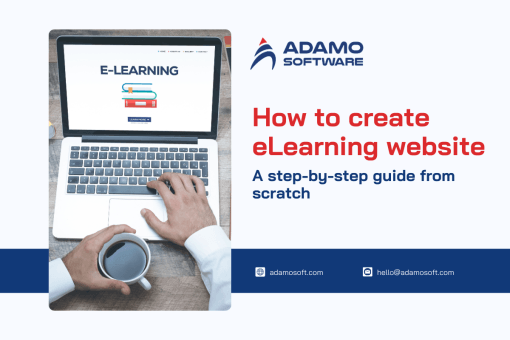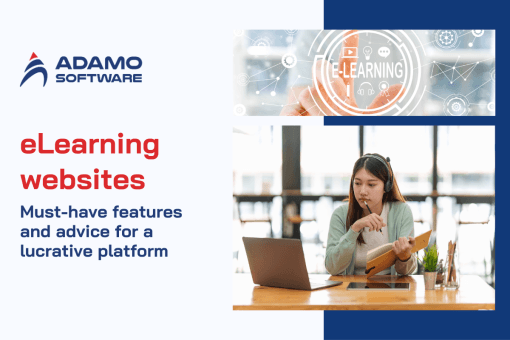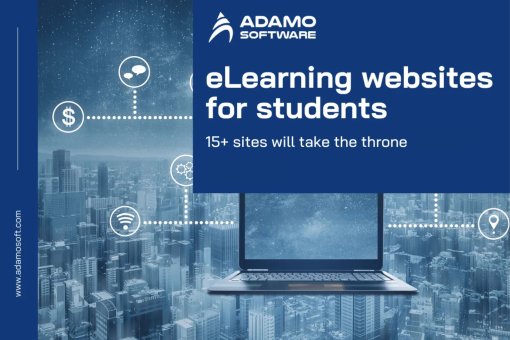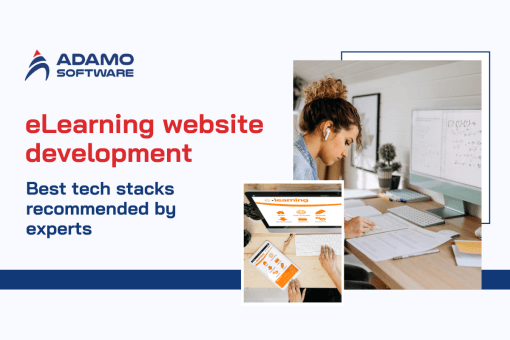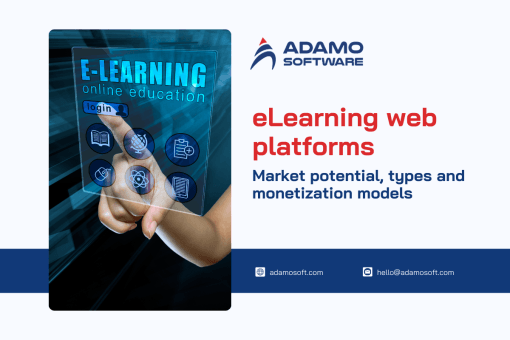Develop LMS Solutions: How to Select the Right Learning Technology Stack for Business

Discover the essential tech stacks and the reasons behind the relevance for the objectives of your LMS solutions. Check it out.
Designing a flexible User Interface is just one facet of building LMS solutions. It involves creating a secure, scalable, and feature-rich application that enables the corporate software development company to generate revenue while satisfying clients and prospects. Choosing the right technology stack is essential in this context.
The technology stack plays a crucial role in defining the scalability, performance, and maintainability of the LMS solutions. This blog will provide you with essential insights and elements to assist you in making a well-informed decision.
I. Elements to consider when selecting tech stacks for LMS solutions
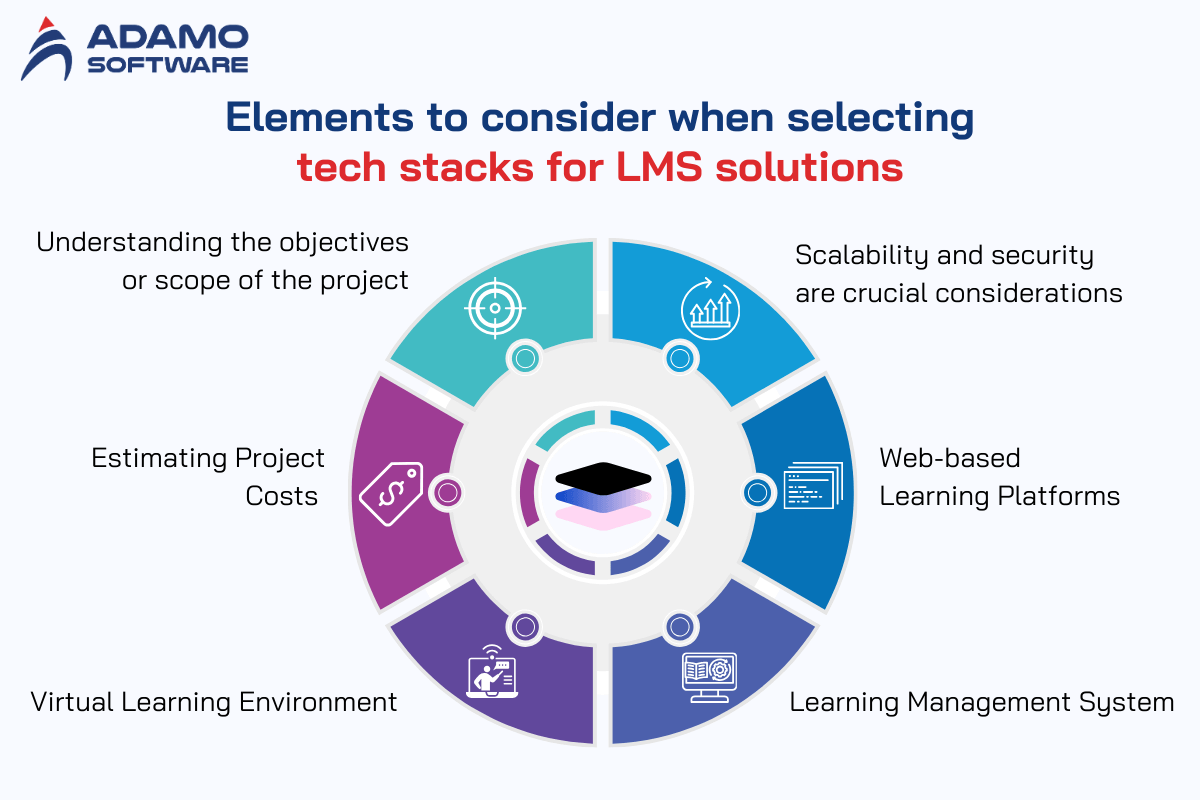
1. Understanding the objectives or scope of the project
Prior to selecting a technology stack, it is essential to first outline the scope of the LMS solution project. The scope of the project will dictate the size of the application. A range of tools and technologies will be necessary for both large- and small-scale initiatives. To launch their LMS solutions quickly, one might consider utilizing a pre-existing app development solution.
2. Scalability and security are crucial considerations
After the official launch of LMS solutions, the developer might encounter a situation where adjustments are necessary based on user feedback. Consequently, selecting tools and technologies that support scalability is essential. Moreover, not all programming languages and frameworks can be considered completely dependable for mobile app development. Once the app has been developed, it might be essential to perform a security assessment on both the server and client sides to address any security vulnerabilities.
3. Estimating Project Costs
When deciding on the technology stack to use, take into account the expenses associated with app development and the duration required to build an LMS solution. There are numerous free frameworks available on the internet. Conversely, numerous frameworks function on a subscription model, necessitating a fee to unlock additional features. Additionally, certain technologies can be challenging to understand. When hiring a dedicated development team to create an educational app, it is essential to consider the associated training costs as well.
4. Web-based Learning Platforms
Most of the subjects covered in contemporary educational institutions bear minimal relevance to aiding students in their life progression. Today’s students have become increasingly intelligent and aware of what will most effectively help them reach their goals. The increase in tuition fees at schools and colleges has provided students with yet another incentive to utilize eLearning web portals.
LMS solutions have gained global popularity as they provide students with precisely the content necessary to enhance their overall knowledge. These eLearning resources primarily aim to enhance the critical thinking skills of students.
5. Virtual Learning Environment
Virtual classrooms are online learning environments that facilitate real-time interaction between instructors and students or learners during educational activities. It serves as a digital platform for educators and learners to collaborate effectively towards shared objectives.
Most discussions in this educational setting occur through video conferencing. Those responsible for online education are equipped with resources to present information that can be effectively learned through various methods. They possess the ability to collaborate in groups as well as work autonomously. The instructor plays a crucial role in organizing the learning process and encouraging group work and discussions.
6. Learning Management System
The function of LMS solutions is shaped by various factors, such as the organization’s online training strategy, objectives, and desired outcomes. A LMS solution is designed to deliver and oversee online training. Assets are often uploaded to a Learning Management System for easy access by distance learners. Conversely, numerous LMS solutions come with integrated authoring features, simplifying the process of creating online training courses without the need for external software.
II. Why technology stack is crucial in LMS development
Before diving into the selection of the appropriate Tech Stack for your LMS solutions, it is essential to grasp the significance of choosing the right technology stack for your needs.
Here are the ways it impacts your app development process:
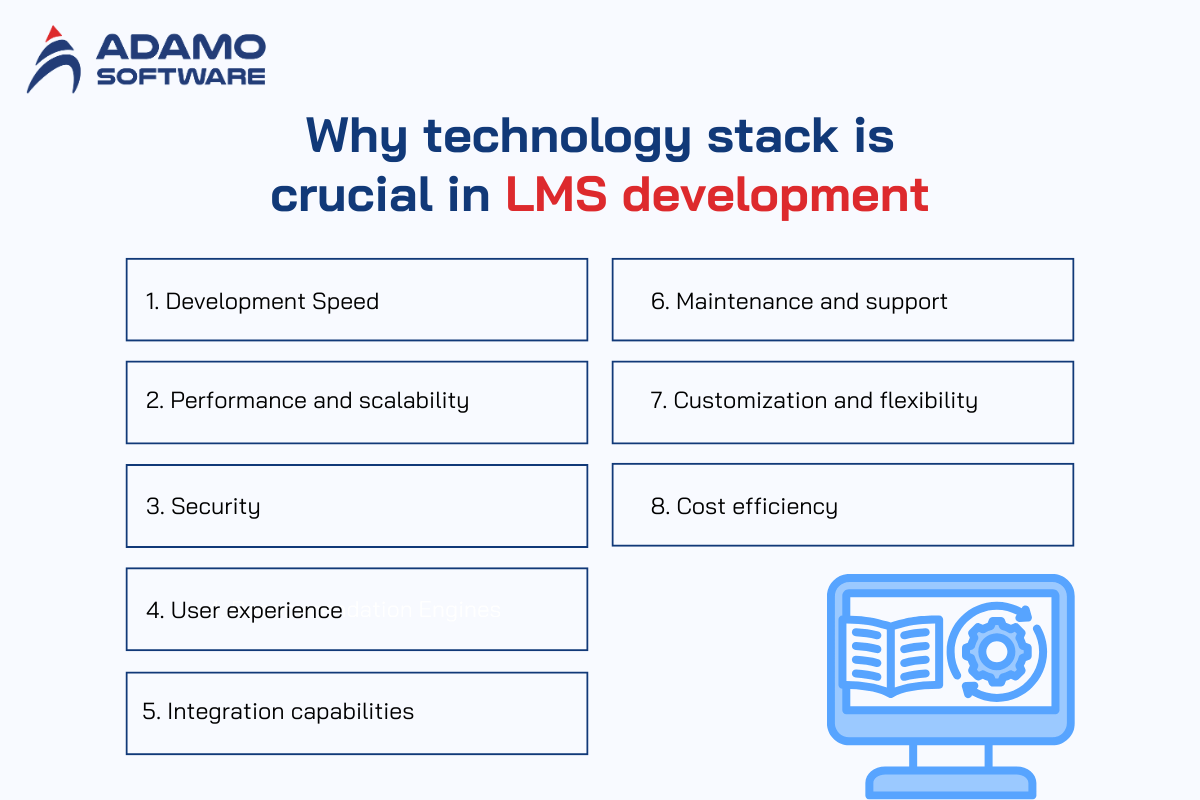
1. Development Speed
Using the appropriate tools and backend frameworks, developers can efficiently create prototypes and refine features, accelerating the entire app development process. Additionally, modern tech stacks frequently incorporate libraries and frameworks that offer reusable components, which help to decrease development time.
2. Performance and scalability
An appropriate tech stack guarantees that the LMS solutions operate effectively, managing a significant volume of users and data without experiencing any slowdowns. The app is designed to expand and support a growing number of users and features seamlessly, avoiding significant overhauls or performance problems.
3. Security
The technology stack has a direct impact on the security of an LMS solution. A suitable tech stack will incorporate strong security features and practices to safeguard user data and avert breaches. It assists in complying with industry standards and regulations concerning data privacy and security.
4. User experience
The application operates efficiently when the appropriate technology stacks are selected, ensuring an intuitive and appealing user experience. Technologies that facilitate responsive design guarantee that the eLearning app functions effectively across a range of devices, from desktops to mobile phones.
5. Integration capabilities
A well-chosen tech stack facilitates smooth integration with various third-party services and APIs, including payment gateways, content management systems, and analytics tools. The application facilitates integration with various tools and services as it evolves and expands.
6. Maintenance and support
A stack with robust community backing and consistent updates facilitates the ongoing maintenance and enhancement of the app as time progresses. Technologies that are well-supported typically include regular patches and bug fixes, essential for maintaining the stability and security of the LMS solutions.
7. Customization and flexibility
With the appropriate technologies, customization to suit the unique needs and preferences of users is straightforward. It allows for adaptability to evolving needs and new technologies, ensuring that the app remains a popular topic of conversation.
8. Cost efficiency
Utilizing open-source tools and cross-platform app platforms can lead to cost reductions when compared to proprietary solutions. Effective technology stacks enhance server utilization and lower operational costs.
III. Ideal tech stacks for LMS solutions
Choosing a technology stack for LMS solutions requires careful consideration of factors like scalability, user-friendliness, community support, and the particular features you wish to incorporate. The following is a suggested technology stack that includes different elements of LMS solutions.
1. Frontend development
The frontend of an LMS must be intuitive and adaptable, ensuring a smooth experience on various devices. Some widely used frontend technologies are:
- HTML5 and CSS3: For web page structural and style aid.
- JavaScript: For interactive elements and dynamic content.
- React: A quite well-liked tool for creating reusable component user interfaces.
- Angular: Strong structure for creating extensive feature-based large-scale projects.
- Vue.js: A progressive framework for gently learning curve user interface creation.
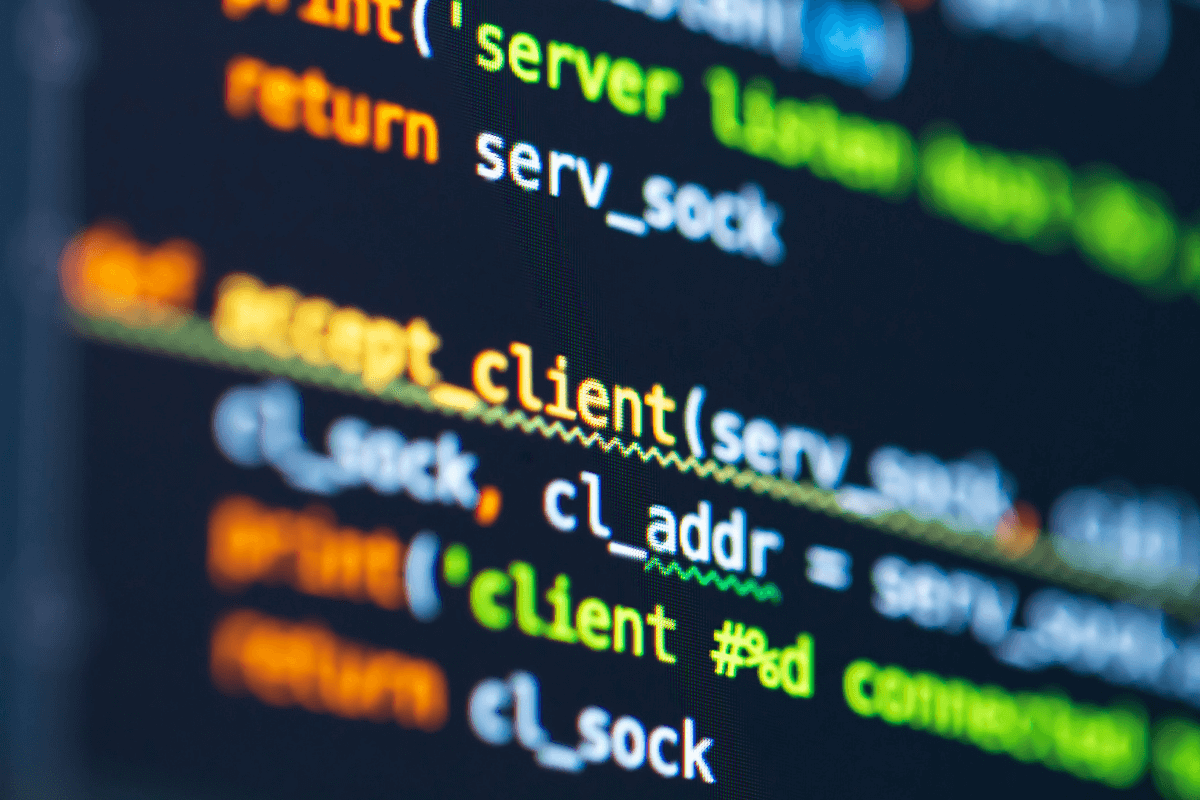
2. Backend development
Comprising data processing, authentication, and server-side logic, the backend drives your LMS. Common backend technologies consist of:
Programming languages:
- Node.js: A real-time application suitable with non-blocking, event-driven architecture.
- Python: Popular for its simplicity and large libraries—with frameworks like Django and Flask.
- With the Ruby on Rails framework, Ruby—known for its simplicity and efficiency—is more accessible.
- Java: A strong, high-performance language sometimes seen in applications of corporate grade.
- PHP: Mostly used in web development using Laravel among frameworks.
Databases:
- MySQL: A trustworthy open-source database that a lot of people use.
- PostgreSQL: Known for having a lot of advanced features and being compatible with SQL standards.
- NoSQL databases.
- MongoDB: A flexible database that works with documents.
- Cassandra: It can handle a lot of info and is available all the time.
3. Middleware and API
Middleware serves as a link between the frontend and the backend, facilitating communication and data exchange. APIs (Application Programming Interfaces) allow various components of the LMS to communicate seamlessly. Consider using:
- RESTful APIs: Web service standards that provide a clear approach to API architecture.
- GraphQL: An alternative to REST that allows for more flexibility when querying data.
- Middleware Platforms
- Express.js: A lightweight and adaptable Node.js web application framework.
- Koa.js: A lightweight and expressive framework for Node.js applications.
4. Authentication and Security
Ensuring security is crucial in LMS solutions, as it safeguards sensitive user information and blocks unauthorized access. Establish strong authentication and security protocols:
Authentication:
- OAuth2: A widely recognized protocol used for authorization in the industry.
- JWT (JSON Web Tokens): A method for secure token-based authentication.
- Single Sign-On (SSO): Enables users to access various applications using a single set of login credentials.
Security measures:
- HTTPS: Guarantees secure communication across the network.
- Data Encryption: Safeguards data both when stored and during transmission.
- Consistent Security Audits: Detects and addresses vulnerabilities.
5. Scalability and performance
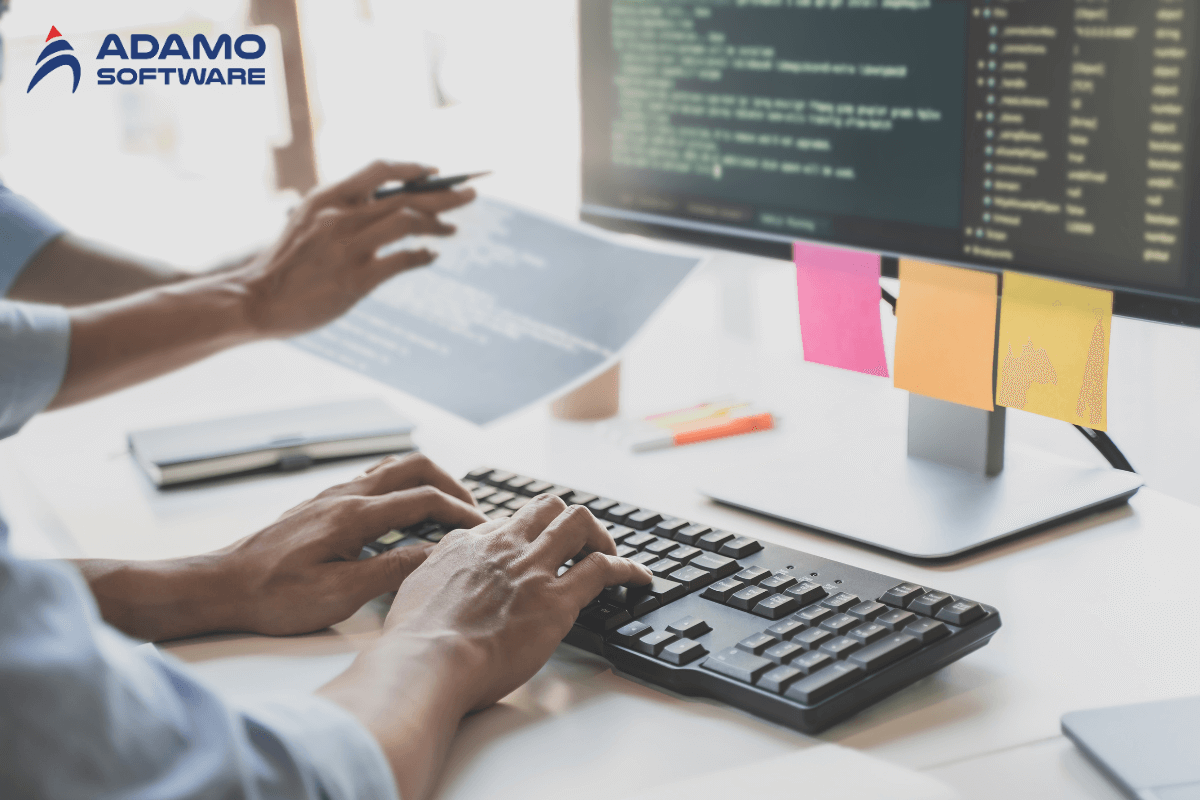
Scalability and performance are essential for supporting an increasing number of users and content. Select technologies that facilitate:
- Load Balancing: Allocates traffic among several servers to improve performance.
- Caching: Enhances load times and decreases server load (e.g., Redis, Memcached).
- Cloud Services: Providers such as AWS, Google Cloud, and Azure deliver scalable infrastructure and services.
6. Development tools and DevOps
- Effective development and deployment processes are crucial for prompt delivery and ongoing enhancement. Make use of:
- Version Control: Utilizing Git for managing source code and facilitating collaboration.
- CI/CD Pipelines: Streamline the processes of testing and deployment (e.g., Jenkins, GitHub Actions).
- Containerization: Utilizing Docker for uniform environments and seamless scaling.
- Monitoring and Logging: Utilizing tools such as Prometheus, Grafana, and the ELK Stack to effectively track performance and troubleshoot issues.
Also read: Explore LMS Cost in 2024 – Which LMS Pricing Model that Fits You
IV. How can Adamo Software help you develop your LMS solutions
Creating a successful eLearning app requires a blend of technical expertise, educational understanding, and innovative design. Adamo Software is the ideal partner for this endeavor. We provide comprehensive eLearning app development services to turn your LMS vision into reality. Our team of skilled and dedicated mobile app developers, designers, and educational tech experts collaborates to ensure your app is both functional and engaging. We are with you from the initial consultation to the final launch, guiding you in defining your project’s scope, goals, and technical requirements at every stage.

Adamo Software excels in crafting personalized eLearning solutions tailored specifically for you. We develop scalable, secure, and user-friendly applications that improve the learning experience through the use of cutting-edge technologies. We specialize in incorporating interactive content, gamification, and real-time analytics to enhance learner engagement and motivation. Collaborate with Adamo Software to create exceptional LMS solutions that foster educational achievement and align with your business objectives.







